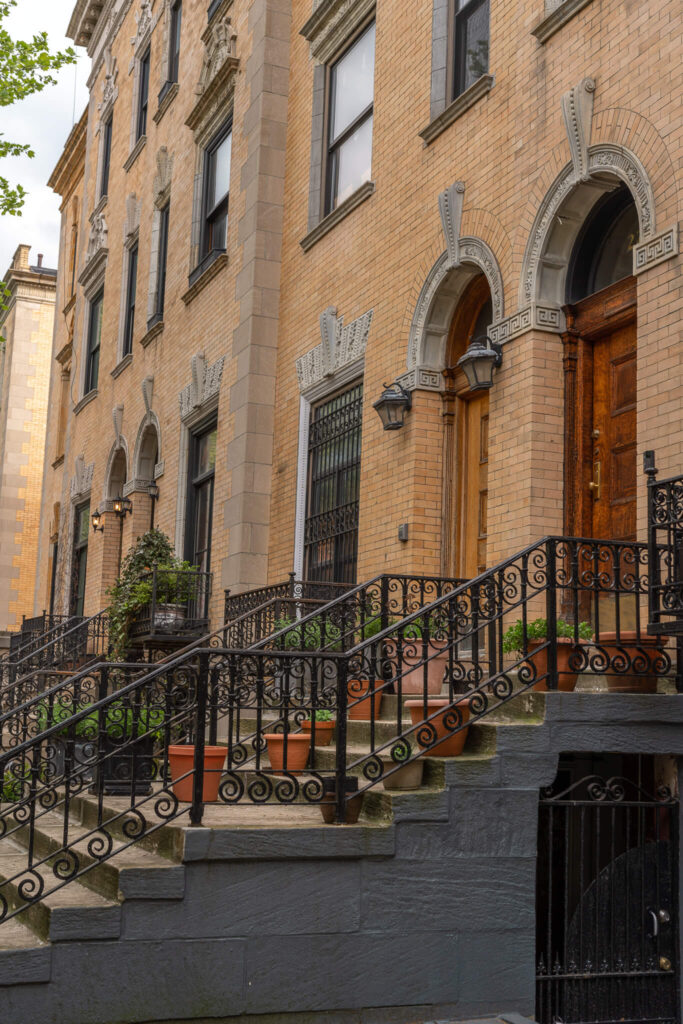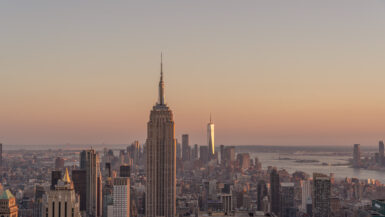Harlem is a district surrounded by many legends. We’ve heard both that it’s dangerous and that there’s nothing interesting to see there. We decided to experience it firsthand, and as you can see, there are at least 11 places to see in Harlem, and probably many other interesting places we haven’t visited yet! Other, more popular, worth to visit places in Manhattan are included in this post.
Harlem is an extremely fascinating neighborhood of New York from a historical perspective. It’s located at the northern end of Manhattan Island. Harlem was founded in the 17th century by the Dutch, who were the first settlers of New York. It was they who gave it its name, originally spelled as Haarlem, and over time, it was anglicized to its current form. Originally, Harlem was a small village, and its residents were engaged in farming.
The development of Harlem is closely linked to the development of railways. Initially, due to its distance from the city, there were wealthy estates in the area. The railway network reached 129th Street between 1878 and 1881, making both faster and cheaper travel to lower Manhattan possible. With the beginning of the 20th century and the Great Migration, the influx of the Black population into Harlem began. The abolition of slavery in the southern states did not change the attitudes of the white population, who were hostile towards the African American population, which started migrating north to places like New York, which was much more liberal.
In the 1920s and 1930s, Harlem experienced a rebirth, known as the ‘Harlem Renaissance,’ a period of dynamic cultural and artistic development. The Harlem Renaissance is considered the best period of the district. The situation worsened after the Great Depression in 1929, leading to job loss for many residents of the district. Matters didn’t improve due to World War II, and Harlem slowly fell into neglect.
The worst years are considered to be the 1970s and 1980s, when the crisis affected the entire city, and Black Harlem fell into oblivion. During these years, there was a sharp increase in crime and drug addiction, and much of the neighborhood fell into ruin. Harlem was also plagued by fires caused by building owners who used them to claim insurance money and get rid of problematic properties they couldn’t afford to renovate. The situation began to slowly change in the 1990s, and now a significant part of Harlem has been gentrified. Property prices are rising, and the percentage of Black residents who can’t afford rent is decreasing.
Is Harlem safe? Certainly, it’s not as unsafe as it used to be, but it’s important to use common sense, just like in any other place, and avoid the district at night. West and Central Harlem are considered relatively safe areas, especially the vicinity of Columbia University, which is considered a good area. Visiting East Harlem is not recommended, as it’s reportedly the least safe part (we haven’t been to that area ourselves). We’ve also heard opinions that it’s best not to venture anywhere north of 125th Street; Aneta visited those areas both alone and in a group. If you have concerns about safety, we recommend taking a guided tour organized by groups like Guru Walk.
Columbia University – 11 Places to See in Harlem
Columbia University is a private institution belonging to the prestigious Ivy League, which comprises 8 American private research universities recognized as the best higher education institutions in the United States. Originally established as King’s College on lands owned by Trinity Church in Lower Manhattan, Columbia University is the oldest higher education institution in New York and the fifth oldest in the USA.
Access to the university campus is open to the public (external areas of the campus), but it’s worth considering a historical tour with a guide or a self-guided tour, which you can learn more about here.


Morris-Jumel Mansion – 11 Places to See in Harlem
At the beginning of New York’s existence, Harlem was a separate village located to the north of the city. Wealthy Dutch settlers established farms there, and the character of the neighborhood changed with the development of the railway that connected the city to the village. Over time, New York absorbed Harlem, and the district underwent further changes.
One of the remnants of early Harlem is the Morris-Jumel Mansion, one of the oldest surviving residences on Manhattan to this day. The mansion was built in 1765 for the Morris family. During the American Revolutionary War, the mansion served as the headquarters for General George Washington’s troops, as well as for British and Hessian forces. In subsequent years, it was used as a tavern, and in 1810, the villa was purchased by Stephen and Eliza Jumel, who began a series of renovations. The last private owners of the house in 1904 transformed it into a museum.
You can learn more about visiting the mansion here.


Sylvian Terrace – 11 Places to See in Harlem
Sylvian Terrace is a place that looks like it’s been transported from another era. Sylvian Terrace is a street with 20 historic, two-story wooden buildings constructed between 1882 and 1883. This street leads directly to the Morris-Jumel Mansion and is part of the historic Jumel Terrace district, where most buildings were built between 1890 and 1902.


The City College of New York – 11 Places to See in Harlem
The City College of New York, founded in 1847, was the first public institution that provided free education (unfortunately, tuition is now charged). The idea behind this institution was to provide access to education and assimilation into society for poor immigrants who flocked to the United States from Europe in the 19th century. Over the years, the college has educated many Nobel laureates, journalists, scientists, and politicians. Among the notable alumni of The City College of New York are individuals such as Ed Koch (Mayor of New York City) and Mario Puzo (author of The Godfather).
One of the most distinctive buildings to pay attention to is Shepard Hall, designed in the style of late Gothic revival. Shepard Hall was the first building of the college in its new location. In this area, you won’t miss other impressive buildings: Townsend Harris Hall, Compton-Goethals Hall, and Wingate Hall.


Hamilton Grange National Memorial – 11 Places to See in Harlem
While visiting The City College of New York, it’s easy to overlook the Alexander Hamilton House located at its base in St. Nicholas Park (Alexander Hamilton was one of the Founding Fathers and the Secretary of the Treasury). Alexander Hamilton lived in Harlem and commuted on horseback to lower Manhattan for work. His estate was slightly north of its current location, and in 2008, the entire house was relocated to its present site.


Strivers’ Row – 11 Places to See in Harlem
Strivers’ Row is a historic area within the St. Nicholas Historic District, occupying the area between 138th and 139th Streets West, situated between Adam Clayton Powell Jr. Boulevard and Frederick Douglass Boulevard. Strivers’ Row is one of the most picturesque places in Harlem. The brownstone townhouses of Strivers’ Row were built by developer David H. King Jr. between 1891 and 1893. The district includes three types of buildings: those made of red brick and brownstone, buildings made of yellow brick, limestone, and terra cotta, and those made of dark brick, brownstone, and terra cotta.
This development was designed for the white middle class, but due to a limited number of houses sold, during the economic crisis, white residents began leaving Harlem. Despite significant interest, the company did not sell houses to Black residents, and these houses remained vacant until 1919-20. The name “Strivers'” was given by Black leaders and professionals who eventually succeeded in moving into this area.


Adam Clayton Powell Junior Boulevard – 11 Places to See in Harlem
Adam Clayton Powell Jr. was a pastor and politician associated with Harlem, who represented the district in the United States House of Representatives from 1945 to 1971. Adam Clayton Powell Jr. was the first African American elected to Congress. In his honor, the 7th Avenue in the portion running through Harlem was named Adam Clayton Powell Junior Boulevard.
Apollo Theater – 11 Places to See in Harlem
The legendary Harlem theater where African American artists have performed (and still perform). The Apollo was popular during the “Harlem Renaissance” and the 1960s. However, things changed with the crisis that struck a decade later. Due to increased crime and drug addiction in Harlem, the theater closed in 1976. After years of challenges, it was successfully revived, and in 1983, the theater was designated a “New York City Landmark.”
The Apollo is famous for its Amateur Night talent show, held on Wednesdays for amateur performers. Anyone can compete for a prize of $20,000, judged by the audience actively participating in the event. Amateur Night continues to this day, so if you’re planning a visit to Harlem, you can plan a Wednesday evening at the Apollo. Many amateurs who won this show went on to have successful careers, including notable stars like Ella Fitzgerald, Jimi Hendrix, and Billie Holiday.


Mount Morris Park West – 11 Places to See in Harlem
Mount Morris Park West is another affluent area in addition to Strivers’ Row, attracting prominent residents of Harlem. Mount Morris Park West is also a historic district where you can admire the characteristic urban brownstone buildings of Harlem.
Marcus Garvey Park – 11 Places to See in Harlem
Marcus Garvey Park is located near Mount Morris Park West, lying on the border between Central and East Harlem. Marcus Garvey Park was the site of the Harlem Cultural Festival from 1967 to 1969, held annually. It gained significant popularity in 1969 and was dubbed the “Black Woodstock.” A documentary called ‘Summer of Soul’ was made about the festival.
In Marcus Garvey Park, you’ll also find the ‘Harlem Fire Watchtower,’ the last of 11 observation towers that have survived to this day. The tower dates back to the 19th century and was, as the name suggests, an observation tower used to spot fires, which were a significant problem for the city at that time.


The Abyssinian Baptist Church – 11 Places to See in Harlem
In 1808, a group of sixteen people who rebelled against the segregation of seats at the First Baptist Church of New York decided to establish The Abyssinian Baptist Church in Lower Manhattan. The name comes from the ancient name of Ethiopia – Abyssinia. This was the first African American Baptist church in the state of New York. The church moved north on the island with changes in the city and settled in its present location at 138 West during the Harlem Renaissance. This church is a popular destination for Sunday gospel services among tourists. If you plan to attend such an event, it’s worth checking which services allow tourists and whether there are limits on the number of seats. Due to high demand, consider choosing a smaller, less known church.







